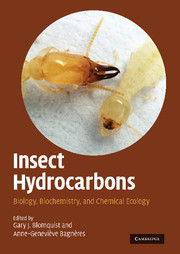Book contents
- Frontmatter
- Contents
- List of contributors
- Foreword
- Acknowledgments
- Part I Chemistry, Biochemistry, and Physiology
- Part II Chemical Communication
- 10 Perception and olfaction of cuticular compounds
- 11 Nestmate recognition in social insects and the role of hydrocarbons
- 12 Cuticular hydrocarbon cues in the formation and maintenance of insect social groups
- 13 Hydrocarbon profiles indicate fertility and dominance status in ant, bee, and wasp colonies
- 14 Chemical deception/mimicry using cuticular hydrocarbons
- 15 Behavioral and evolutionary roles of cuticular hydrocarbons in Diptera
- 16 Contact recognition pheromones in spiders and scorpions
- 17 Hydrocarbons as contact pheromones of longhorned beetles (Coleoptera: Cerambycidae)
- 18 Polyene hydrocarbons, epoxides, and related compounds as components of lepidopteran pheromone blends
- 19 Volatile hydrocarbon pheromones from beetles
- 20 Future directions in hydrocarbon research
- Index
17 - Hydrocarbons as contact pheromones of longhorned beetles (Coleoptera: Cerambycidae)
from Part II - Chemical Communication
Published online by Cambridge University Press: 18 May 2010
- Frontmatter
- Contents
- List of contributors
- Foreword
- Acknowledgments
- Part I Chemistry, Biochemistry, and Physiology
- Part II Chemical Communication
- 10 Perception and olfaction of cuticular compounds
- 11 Nestmate recognition in social insects and the role of hydrocarbons
- 12 Cuticular hydrocarbon cues in the formation and maintenance of insect social groups
- 13 Hydrocarbon profiles indicate fertility and dominance status in ant, bee, and wasp colonies
- 14 Chemical deception/mimicry using cuticular hydrocarbons
- 15 Behavioral and evolutionary roles of cuticular hydrocarbons in Diptera
- 16 Contact recognition pheromones in spiders and scorpions
- 17 Hydrocarbons as contact pheromones of longhorned beetles (Coleoptera: Cerambycidae)
- 18 Polyene hydrocarbons, epoxides, and related compounds as components of lepidopteran pheromone blends
- 19 Volatile hydrocarbon pheromones from beetles
- 20 Future directions in hydrocarbon research
- Index
Summary
The cuticular wax layer of insects is comprised of a complex mixture of long-chain fatty acids, alcohols, esters, aldehydes, ketones, and hydrocarbons that protect insects from desiccation (Gibbs, 1998). The components of the wax layer, particularly the hydrocarbons, also act as contact pheromones that mediate mate recognition (Howard and Blomquist, 2005). In fact, there is a growing body of evidence that contact pheromones play important roles in the mating systems of beetles in the family Cerambycidae, the longhorned beetles (e.g., Kim et al., 1993; Fukaya et al., 1996, 1997, 2000; Wang, 1998; Ginzel et al., 2003a, 2003b, 2006; Ginzel and Hanks, 2003, 2005; Lacey et al., 2008). These chemical signals elicit mating responses from males and have been confirmed in a number of cerambycid species, including those in the primitive subfamily Prioninae (Barbour et al., 2007), and more derived subfamilies of Cerambycinae (e.g., Ginzel and Hanks, 2003; Ginzel et al., 2003a, 2003b, 2006; Lacey et al., 2008) and Lamiinae (e.g., Wang, 1998; Fukaya et al., 2000; Ginzel and Hanks, 2003; Yasui et al., 2003; Zhang et al., 2003; see Table 17.1).
Cerambycid beetles are collectively known as longhorned beetles because many species have elongate filiform antennae (Linsley, 1964), and this diverse family includes more than 35, 000 species in ∼4, 000 genera (Lawrence, 1982).
- Type
- Chapter
- Information
- Insect HydrocarbonsBiology, Biochemistry, and Chemical Ecology, pp. 375 - 389Publisher: Cambridge University PressPrint publication year: 2010
- 30
- Cited by



